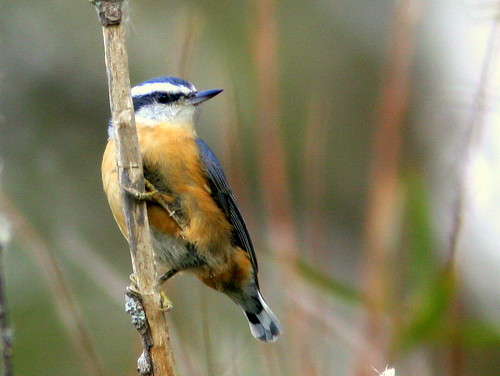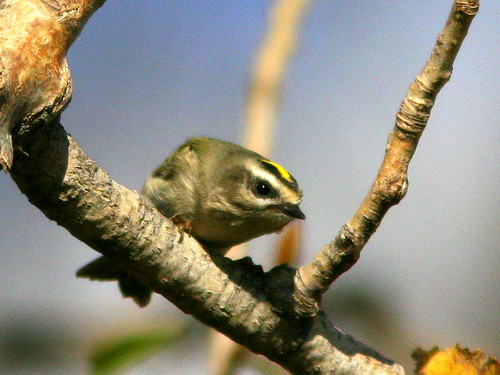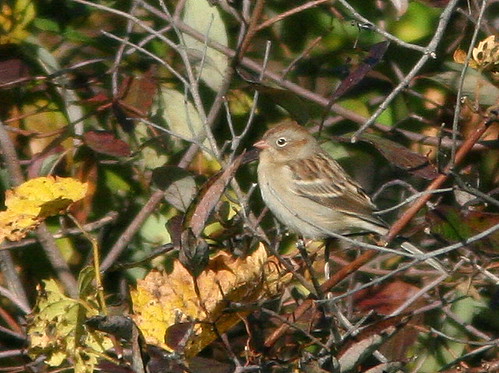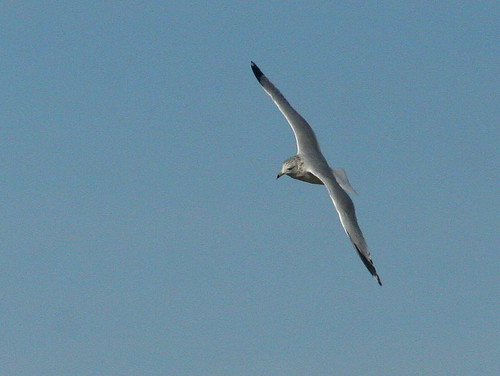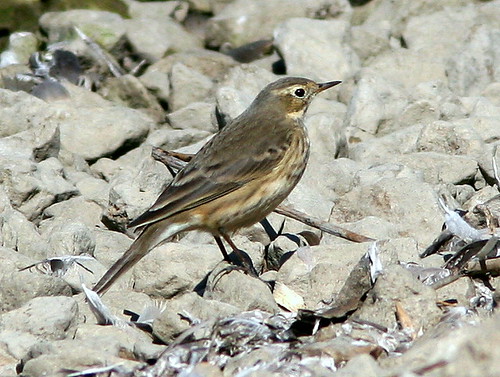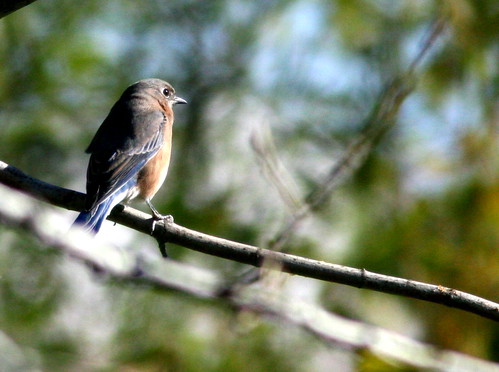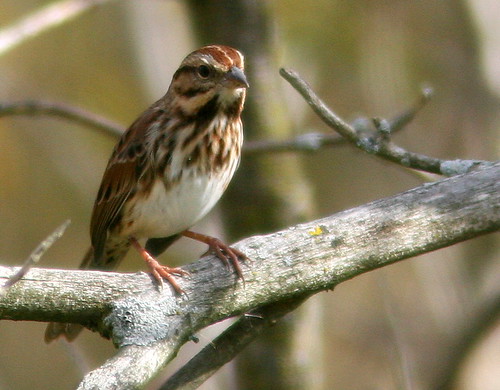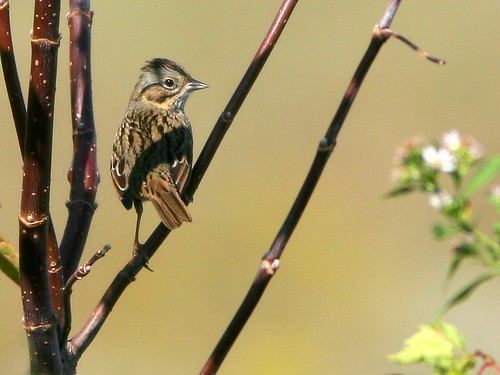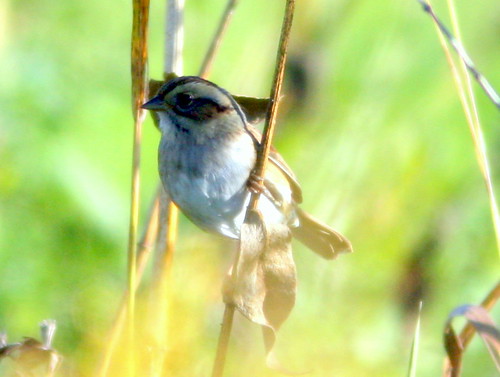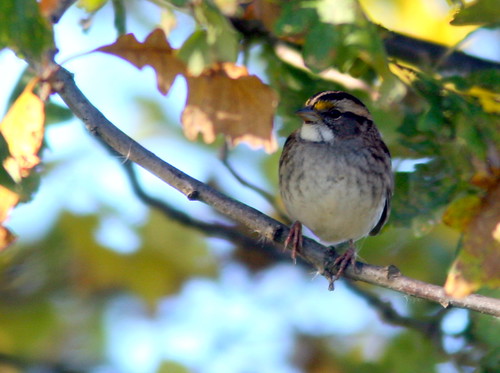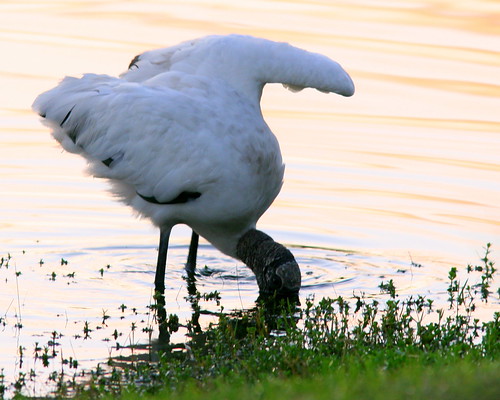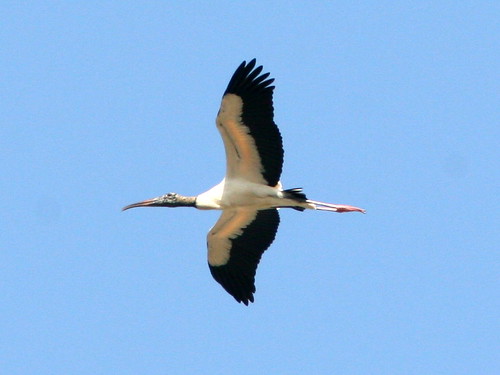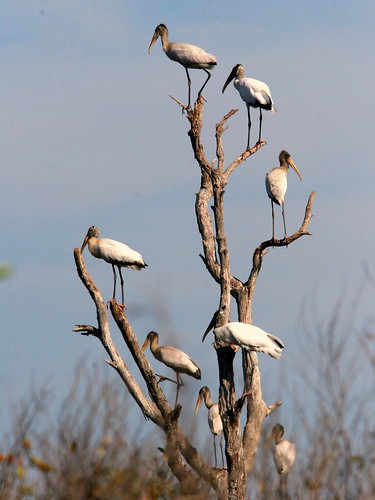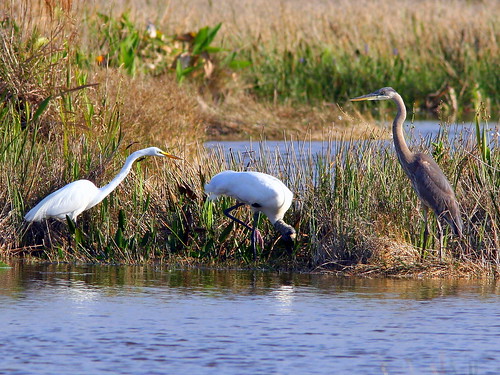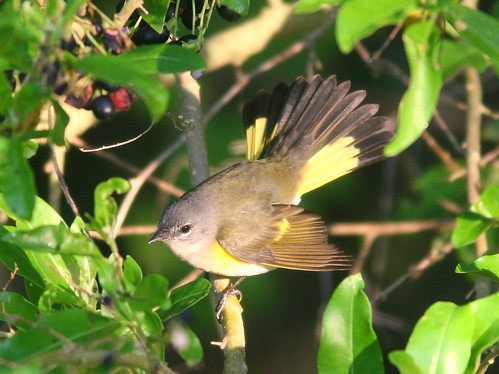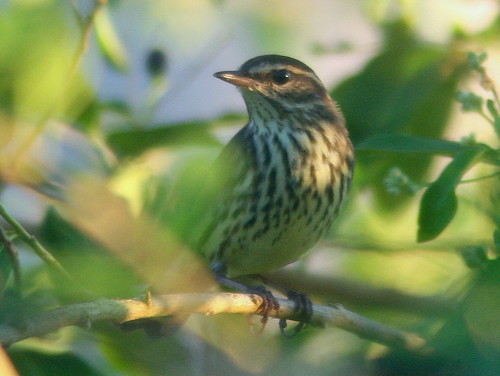The Red-breasted Nuthatch mostly nests just north of the Chicago area, but spends the winter here, joining its larger White-breasted cousin. Both birds have slightly upturned bills, an adaptation for foraging upside down on tree trunks.
Red-breasted Nuthatch:
The locally-breeding White-breasted Nuthatch strikes a classic head-down pose:
The two kinglet species are also migrating through northern Illinois While the Ruby-crowned Kinglets will continue on south, the Golden-crowned species will stay for the winter.
The Ruby-crowned Kinglet is usually reluctant to flaunt the red feathers to which he owes his name. One might see a hundred of these active little birds before getting a glimpse of their ruby crown. I have seen it most often in the spring, in encounters between two singing males. At Nelson Lake/Dick Young Kane County Forest Preserve, I witnessed what appeared to be an aggressive exchange between two Ruby-crowns, during which one of the birds repeatedly, but very briefly, erected the red feathers atop its head.
The active little bird moved too fast for my camera, and this blurry photo was the only one to exhibit the ruby crown:
This spring, I did catch one in full display: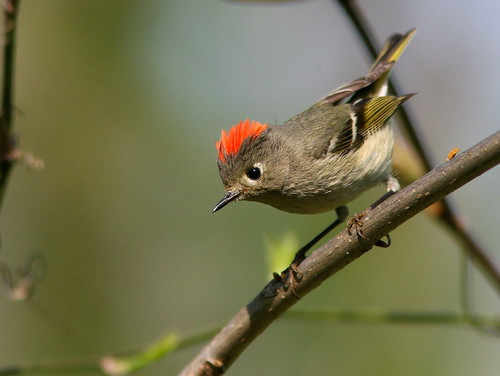
Last week, Mary Lou and I encountered an unusually large group of Golden-crowned Kinglets at Jones Meadow Park, a small oasis of woodlands and wetlands in suburban Kane County, Illinois. On the return leg of our walk, we stopped by a Cottonwood grove. Golden leaves littered the ground underneath the trees, which were now almost entirely bare.
Golden-crowned Kinglet:
Initially we found no birds among the stark branches, back-lit by a cloudy morning sky. Just as we were about to stop looking, the first contingent of kinglets appeared out of nowhere. They worked their way across the grove, streaming from left to right. In groups of 5 or 6, there may have been as many as two dozen birds, unaccompanied by the (usually) more common Ruby-crowned Kinglets. Since Cottonwoods shade out and self-prune their lower branches, most of the birds were up pretty high, but some flew into a few saplings near us along the trail, and they provided a great photo opportunity.
This kinglet seemed curious about my presence:
The birds were extremely active, so I caught them fluttering…
…taking big leaps…
…Olympic-class dives…
Their proximity allowed me to capture other aspects of their typical behavior, such as hover-gleaning:
We also re-visited Fermilab in DuPage County in hopes of finding Harris’s and Nelson’s Sparrows, but instead saw lots of Field Sparrows:
We saw a hardy Eastern Phoebe, which will soon be forced to depart as its supply of flying insects is depleted by the cold:
Fox Sparrows were singing:
In perfect light, a Ring-billed Gull made a dramatic pass over Lake Law:
We have been enjoying remarkably fair Autumn weather at our second home in northeast Illinois. In between the obligations and joys of sharing time with family and friends, there has been time for at least one birding excursion nearly every day.
One interesting venture last week was with Kane County Audubon Society, to the Fermi National Accelerator Laboratory (Fermilab ). Located in Batavia near Chicago, Illinois, this is a US Department of Energy national laboratory specializing in high-energy particle physics. Fermilab is very birder-friendly, and there is a great variety of natural habitat on their extensive grounds. The official Fermilab web site has an interactive map with links to the various birding “hot spots” within the 6800 acre facility. Peter Kasper updates a current list of bird sightings that is worth watching, as many rarities have appeared there over the years.
We gathered at the famous “Red Barn,” and walked the area known as Village Lakes:
Lake Law is near the start of the trail. It harbored lots of migrating Canada Geese, a pair of Pied-billed Grebes, and a few Green-winged Teal and American Coots:
Two American Pipits along the shore of Lake Law tolerated our close approach:
We had hopes of seeing Harris’s Sparrows, which have appeared in the Chicago area during the past couple of weeks and have been sighted at Fermilab many times in past years. Although I carried my camera on the walk, I put it to little use, something that often happens when I am hiking with a group. Alone, I am free to linger and look for the best shots, but this is hard to do when trying to keep up with other birders. For example, I got great binocular views of an Orange-crowned Warbler, but did not even think of my camera until it had flown into a thicket, the signal for the group to move on. I also failed to obtain photos of Fox Sparrows that lurked in the hedges.
Also in Batavia, but nearer to home, at Nelson Lake/Dick Young Forest Preserve, I did get a good shot of the normally reclusive Fox Sparrow that Mary Lou spotted for me:
We also had better luck with Orange-crowned Warblers, finding them on three consecutive days at Nelson Lake and also this one at Jones Meadow Park in North Aurora, which was foraging with a single Ruby-crowned Kinglet in low vegetation. Note is characteristic broken eye-ring and yellow under the tail:
The Orange-crowned Warbler emerged into full light and plunged off its perch in pursuit of a green insect that looked like a Katydid:
Its free-fall ended with the successful capture of the insect:
Eastern Bluebirds had nested in Jones Meadow Park a couple of years ago, but none were there all summer until this past week, just about when we would expect this species to disappear on its southward migration:
We saw this bluebird at nearly the same location this past spring:
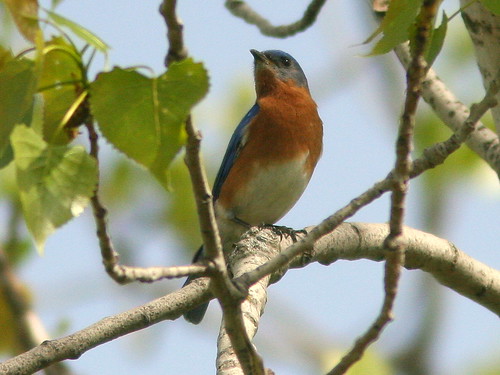
In contrast, a “snow bird,” an early arriving Dark-eyed Junco showed up on the same day. We have been seeing them for about a week, but this was the first I was able to photograph this fall:
White-throated Sparrows sang softly along the asphalt track at Jones Meadow. This is a tan-striped individual. Older field guides often identified these as immature or female birds, in contrast to the white-striped “adults,” but this color variation, usually also showing streaks on the breast, appears in adults of both sexes:
To illustrate the difference, here is a close-up of a white-striped bird that I photographed this past spring at nearby Lippold Park:
Song Sparrows also treated us to short bursts of song. This bird had a particularly reddish tinge to its plumage, initially making me think it was another Fox Sparrow. It reminded me of the southwestern subspecies that I often saw in New Mexico:
Nearby, another streaked sparrow, which I first thought to be a Song Sparrow with an unusually gray head, has the head pattern typical of Lincoln’s Sparrow, as Peter Kasper himself kindly pointed out:
The smaller Savannah Sparrow is shorter-tailed and often shows some yellow in front of its eyes:
INDEX TO ROSYFINCH RAMBLINGS ARCHIVES
Since I am relatively new to digital SLR camera photography, and also because I tend to bird close to home, I have captured images of relatively few of the nearly 600 North American birds that I have identified over these many years. This adds an element of competition and fun to my birdwatching hobby, as I am motivated to newly photograph as many birds as possible. Most of the more common species are already in my set of “Life Birds Photographed,” so it is getting more difficult to add more than one species in a single day. (My set of over 200 bird photos may have a few duplications and omissions, as I have not recently “audited” it for accuracy).
On our first day back in Illinois, Mary Lou and I got out early to Nelson Lake/Dick Young Forest Preserve, not far from our condo in Kane County. The timing of our trip up from South Florida was not opportune, as we overflew many migrants headed in the opposite direction. Yet, we hoped to catch some late migrants and arriving winter resident birds.
As part of the tallgrass prairie restoration program, the grasslands at the east entrance of the Preserve had mostly been mowed. One small patch of grass near the east observation platform had not been disturbed, and it harbored over a dozen sparrows. We identified Song, Savannah, White-throated and White-crowned Sparrows, but the best find was a pair of clear-breasted Clay-colored Sparrows that sported distinctive dark cheek patches. We caught only fleeting glimpses of them through the high grass stalks.
A Savannah Sparrow perched briefly on a tall flower stalk: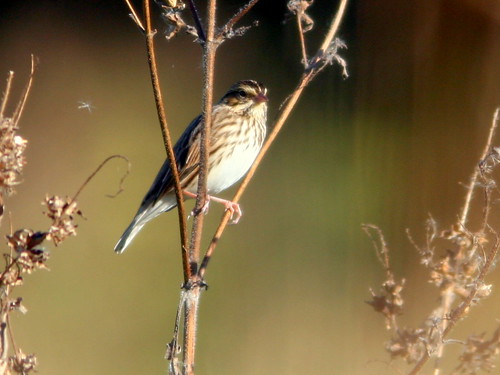
This Clay-colored Sparrow provided me with my first opportunity to (technically poorly) photograph the species:
A distant adult Bald Eagle, very likely one of the pair that nested only about two miles away at Mooseheart, wheeled over the lake:
The tree leaves were already turning into fall colors, and the air was delightfully cool, a welcome respite from Florida’s heat. Along the lake shore, we heard a familiar song. It was loud and melodious, and I did not immediately recognize its source. I first heard this song one spring in Manitoba and was surprised to learn that it came from a sparrow.
A sound clip of the Fox Sparrow song is included in this episode of BirdNote (play the mp3)
We tracked the song to this Fox Sparrow. Its bright reddish brown plumage complemented the autumn colors:
A few White-throated Sparrows also whistled brief versions of their full song:
Calling loudly and continuously, migrating Sandhill Cranes flew overhead:

Late migrants, several Yellow-rumped Warblers foraged for insects amid the goldenrods:
Kinglets seemed to be in every tree. A Ruby-crowned Kinglet paused briefly for a portrait:
I also was able to document the first Golden-crowned Kinglet for my set of “Life Birds Photographed:” 
While both kinglet species often crept out to the ends of twigs, the Ruby-crowned seemed to do more hover-gleaning. I noticed that the Golden-crowned Kinglet tended to spend more time on the trunk and along the larger branches of the tree, nuthatch-style:
Posted by: Ken @ 6:34 am
Wood Stork populations in South Florida have undergone great fluctuations. Breeding success is dependent upon just the right amount of water at the right times. They will not nest at all if there is no water under their rookeries, as the water offers some protection from mammalian predators, particularly raccoons. However, if the water is too deep, alligators will invade the rookery. Once the chicks hatch, it is best if the water depths are receding, as this concentrates the fish. In South Florida, the most optimal foraging months are in mid-winter.
This stork is extending its wing to create a shadow, probably to cause small fish to gather there, as it feeds by touch and not by sight:
Wood Storks are most efficient at catching fish and crayfish that are 1-6 inches in length, generally over one year old. Therefore, successful foraging is restricted to areas that do not dry up entirely before start of the summer rainy season.
This stork, in our back yard, picked up some “salad” with its crayfish:
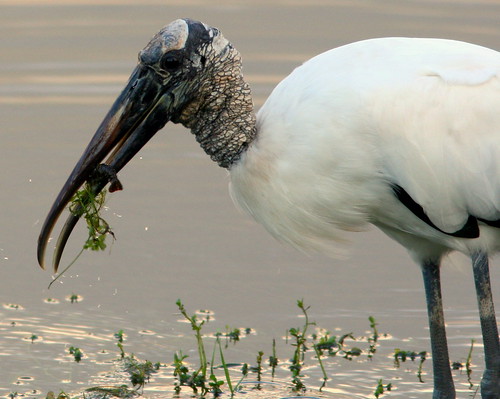
Since they are tactile rather than visual predators, Wood Storks benefit when the water is only 6-10 inches deep and there is a rich “soup” of prey. Young storks require several feedings a day. If water levels are too high or too low, the Wood Storks must fly great distances to find food, and their chicks will starve.
Interestingly, Wood Storks do not fly directly to distant foraging areas. Rather, they must sail on thermals that typically do not develop until mid-morning. This reduces the amount of time that parent birds are able to spend in fishing grounds, increasing the threat to survival of offspring during times when there is too little or too much water.
In January, 2010, a surprisingly large number of immature Wood Storks showed up in our local birding “patch”:
Last year, nesting conditions for Wood Storks were particularly favorable in the Everglades. In censuses taken between 1997 and 2008, the number of successful nests in the Everglades varied widely, between none (in 1998) and a little over 2,000 nests in 2001. More recently there has been a downward trend, with only about 200 active nests in 2008. The number of nests increased dramatically in 2009, to over 4,000.
Immature storks roosted on almost every branch of this dead tree:
Presently, the Wood Stork’s status as an endangered species is being re-evaluated by the US Fish and Wildlife Service. In a preliminary (90-day) finding in response to a petition filed on behalf of the Florida Home Builders
Association. the Agency concluded:
Based on our review, we find that the petition presents substantial scientific or commercial information indicating that reclassifying the U.S. breeding population of the wood stork to threatened may be warranted. Therefore, with the publication of this notice, we are initiating a review of the species’ status to determine if reclassification is warranted.
Irrespective of the agency’s final decision, this species appears to be at risk of localized extinctions, depending on water conditions and continued loss of habitat. (See the updated information below.)
The main purpose of CERP (the Comprehensive Everglades Restoration Program, administered jointly by the US Army Corps of Engineers and the Southwest Florida Water Management District) is to restore sheet flow of clean fresh water to the historic Everglades, at least to the 1/3 to 1/2 of what is left of the “River of Grass.” The Wood Storks would greatly benefit if the original seasonal changes in water lever were reestablished. To do this, many of the ditches and canals that were dug in the middle of the last century to “reclaim” the land for agriculture and development must now be undone.
Aside from the adverse aesthetic and ecological effects, this drainage system also wasted rainwater into the ocean rather than allowing it to recharge our aquifer, which is the source of our drinking water. Decades of excessively low water levels have dried out the peat beds that formerly served as natural “sponges” that helped moderate extremes in flow. Over the years, the peat subsides and compresses, actually forming a barrier that prevents rain water from penetrating, thus increasing runoff and reducing recharge of the aquifer.
Levees are being constructed along the eastern perimeter of the remaining Everglades to control seepage into the ocean and redirect water into its original pathways southward into Everglades National Park. Our own local birding “patch” will eventually be inundated after it is enclosed within a high seepage control levee. We hope that some islands will be constructed within the new reservoir (designated “C-9″ and scheduled for completion in about 10 years), to simulate natural hardwood “hammocks” that dotted the original Everglades. Otherwise we will lose the species that now are harbored in terrestrial habitats.
To control the water flow, CERP is constructing a system of water preservation reservoirs or impoundments. These trap rain water and release it more predictably, actually reducing the threat of flooding in developed land to the east, such as our own neighborhood. The number and size of Stormwater Treatment Areas (STAs) will be increased. These remove excess phosphorus from the water before releasing it to the sheet flow. The phosphorus comes mostly from fertilizer used in agriculture, especially sugar cane cultivation, as well as mining. Healthy Everglades water is normally very poor in nutrients, and the high phosphorus levels allow cattails and exotic plants to replace the Sawgrass. The native plants evolved in the nutrient-poor ecosystem, and are unable to compete with the well-fed invaders.
At the edge of the lawn in our back yard, this Wood Stork stirs the water with its bubble-gum colored feet in hopes of frightening a fish into its waiting open jaws. If they sense a fish, the jaws spring shut. According to the USFWS 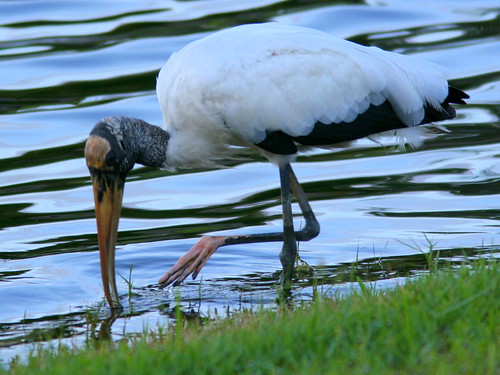
As shown by this photo, the stork typically probes the water with its bill submerged just up to its eyes. It is easy to see why it requires a narrow range of water depths for successful fishing. Its pink feet also look like worms and may attract fish:
In waning light, a Tricolored Heron forages near the stork:
The Tricolored Heron is not endangered, but it also shows wide variance in nesting success in the Everglades, roughly paralleling the Wood Stork trends from year to year.In 2001, nearly 3,500 Tricolored Heron nests were counted, steadily decreasing each year down to about 200 in 2008, and then increasing to 1,200 in 2009.
Several times, I have seen other waders join Wood Storks, perhaps to benefit from fish that are stirred up by the stork. Their differing foraging habits also increase the ability of such a mixed flock to find prey concentrations.
“Fishing Buddies.” A Great Egret, a stork, and a Great Blue Heron congregate in a lake in our birding patch:
Similarly, an egret and a Double-crested Cormorant share a pocket of fish at the edge of our lake:
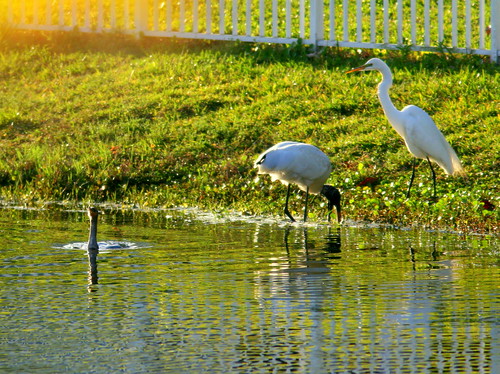
Interactions are not always friendly. Here, a Great Blue Heron chases a Wood Stork up onto a neighbor’s lawn, hoping to steal its booty. It did not succeed:
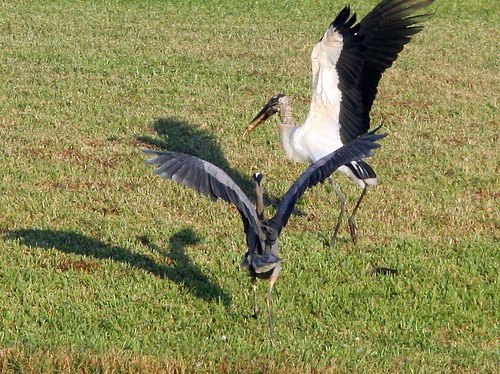
UPDATE (September, 2012)
The Audubon Society provides this evidence-based overview
of the Wood Stork’s precarious status in southern Florida over the last four decades, and the importance of privately-owned wet prairies to their survival.
Although the number of Wood Stork nests outside of South Florida have increased from 1817 in the 1970s to 5491 in the 2000s, the number of nests in South Florida have not recovered, ranging from from 2406 to 2367 over the same period. Nationally the percentage of nests at Corkscrew Swamp declined from 34-37% to only 8% of the US total. There has been total nesting failure at Corkscrew since 2010.
“Audubon has conducted a wood stork foraging study which documented foraging events over the course of two nesting seasons (2006-07 and 2008-09). Data analysis revealed that wet prairies are particularly important to wood storks early in the nesting season. Mapping of foraging locations revealed that 79% of the foraging occurred on private lands in the critical early months of the nesting season. Supporting earlier nesting is critical to recovery efforts for wood stork. This suggests that conservation efforts must involve protecting the foraging values on private lands.”
Florida Home Builders Association v. USFWS
On January 3, 2012, a 60-day notice of intent to sue was sent to USFWS on behalf of Florida Home Builders Association. Attorneys with Pacific Legal Foundation formally warned federal officials that “they will be sued if they do not immediately drop the unjustified listing of the wood stork as ‘endangered’ under the U.S. Endangered Species Act.”
In the meantime, the south Florida rookeries have continued in decline. For the past three years, Wood Storks failed to nest at all in the huge Corkscrew Swamp rookery. To date there has been no final action on the Proposed Rule. For the latest information, visit this
USFWS Wood Stork web page.
Posted by: Ken @ 8:01 pm
As a kid, I remember summer days that seemed endlessly full of discovery. School interfered with enjoyment of both spring and fall migration, but the woods and the warblers were were close by and accessible on weekends. Now the days and weeks and years just fly by. Job lamented (7:6) that his days passed by “swifter than a weaver’s shuttle,” Happily, we learn in the last chapter (42:12) that “the Lord blessed the latter end of Job more than his beginning.” I too, feel blessed.
During migration, I hate to miss even a day of birding. This morning I walked out to our local “patch” just as the sun was coming up. Mary Lou couldn’t make it, but was happy now that she has had good looks at her Ovenbird. My objective was to get photos of one of the male American Redstarts that have been eluding me all week. They scoot so fast that it has been impossible for me to focus on one, as they move along horizontal branches, changing direction and then suddenly deciding that another tree is better than this one.
Walking in, along the unpaved road, I watched the sunlight creep down from the tops of the tallest palms. This kind of light poses photographic challenges for me. There is harsh glare, and images turn out too “warm,” on the orange/red side of the spectrum. My first subject posed such a problem. When I got home I had to process the photos to shift the color more to the “cool” blue side.
On the top of a Royal Palm that had lost its crown and died, a male Northern Flicker probed for a meal :
Although it is possible to set out to see certain “target birds,” my experience has been that most of my best sightings have been unexpected. Sure enough, I saw three male redstarts and my only shot showed just tail feathers, certainly not a “keeper.” However, there were several females, or rather similar immature males, that were more cooperative.
This female American Redstart characteristically fanned its wings and tail. I’m not sure whether the survival value of this trait has been clearly established. I assume the birds show their colored patches to startle insect prey into moving, but this habit may also serve in species recognition and courtship:
An immature male Common Yellowthroat proved to be another difficult subject, and only one of my dozen or so images of it produced an unobstructed side view:
Delightfully, a pair of Black-throated Blue Warblers payed me little heed as they gleaned insects from a small tree. The male was conspicuously marked:

The female, also sporting the trademark white wing patch, is also beautiful in her own way: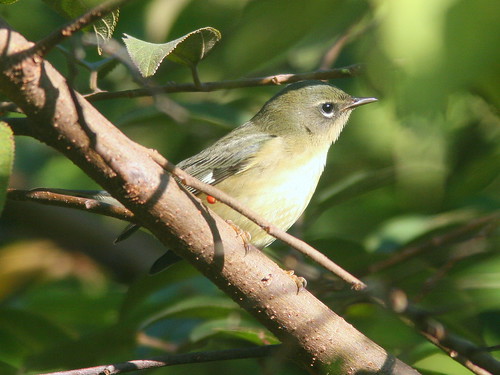
While I was trying to track down another redstart, I perceived movement down on the ground to my right, and was surprised to see an Ovenbird staring at me. It stayed in place while I shifted position to take its picture:

It was ironic how we had searched unsuccessfully for Ovenbirds only last week, and now they seemed to have grown accustomed to human presence. This one high-stepped on pink legs:
Another bird, that I first thought was a second Ovenbird, appeared on a low perch. It was a Northern Waterthrush:
Mary Lou was sure that she had seen a waterthrush here only a couple of days ago, but I could not re-locate it. This bird actually joined the Ovenbird on the ground momentarily, but then flew back to peer out at me from behind the leaves:













